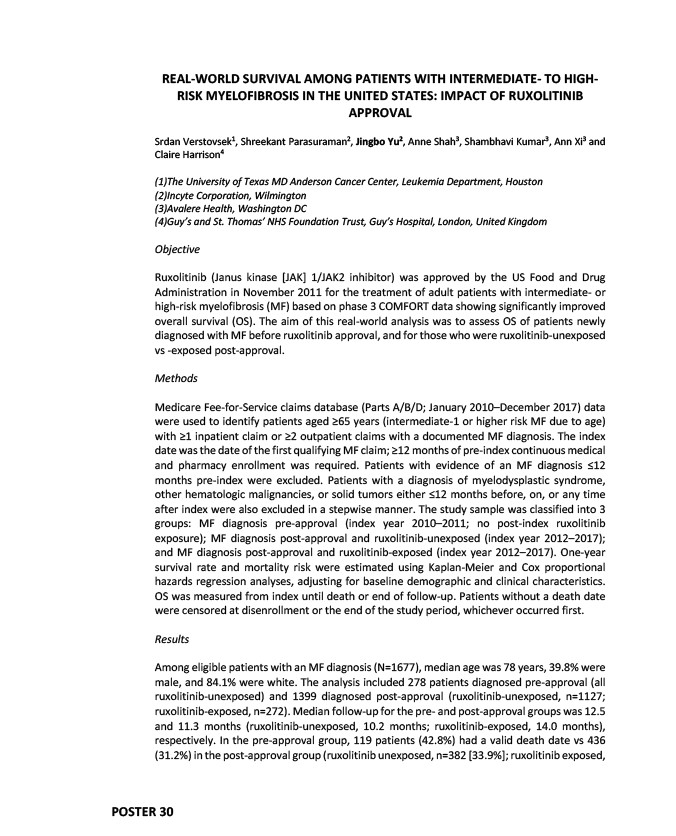
REAL-WORLD SURVIVAL AMONG PATIENTS WITH INTERMEDIATE- TO HIGH-RISK
POSTER 30
MYELOFIBROSIS IN THE UNITED STATES: IMPACT OF RUXOLITINIB
APPROVAL
Srdan Verstovsek1, Shreekant Parasuraman2, Jingbo Yu2, Anne Shah3, Shambhavi Kumar3, Ann Xi3 and
Claire Harrison4
(1)The University of Texas MD Anderson Cancer Center, Leukemia Department, Houston
(2)Incyte Corporation, Wilmington
(3)Avalere Health, Washington DC
(4)Guy’s and St. Thomas’ NHS Foundation Trust, Guy’s Hospital, London, United Kingdom
Objective
Ruxolitinib (Janus kinase JAK 1/JAK2 inhibitor) was approved by the US Food and Drug
Administration in November 2011 for the treatment of adult patients with intermediate- or
high-risk myelofibrosis (MF) based on phase 3 COMFORT data showing significantly improved
overall survival (OS). The aim of this real-world analysis was to assess OS of patients newly
diagnosed with MF before ruxolitinib approval, and for those who were ruxolitinib-unexposed
vs -exposed post-approval.
Methods
Medicare Fee-for-Service claims database (Parts A/B/D; January 2010–December 2017) data
were used to identify patients aged ≥65 years (intermediate-1 or higher risk MF due to age)
with ≥1 inpatient claim or ≥2 outpatient claims with a documented MF diagnosis. The index
date was the date of the first qualifying MF claim; ≥12 months of pre-index continuous medical
and pharmacy enrollment was required. Patients with evidence of an MF diagnosis ≤12
months pre-index were excluded. Patients with a diagnosis of myelodysplastic syndrome,
other hematologic malignancies, or solid tumors either ≤12 months before, on, or any time
after index were also excluded in a stepwise manner. The study sample was classified into 3
groups: MF diagnosis pre-approval (index year 2010–2011; no post-index ruxolitinib
exposure); MF diagnosis post-approval and ruxolitinib-unexposed (index year 2012–2017);
and MF diagnosis post-approval and ruxolitinib-exposed (index year 2012–2017). One-year
survival rate and mortality risk were estimated using Kaplan-Meier and Cox proportional
hazards regression analyses, adjusting for baseline demographic and clinical characteristics.
OS was measured from index until death or end of follow-up. Patients without a death date
were censored at disenrollment or the end of the study period, whichever occurred first.
Results
Among eligible patients with an MF diagnosis (N=1677), median age was 78 years, 39.8% were
male, and 84.1% were white. The analysis included 278 patients diagnosed pre-approval (all
ruxolitinib-unexposed) and 1399 diagnosed post-approval (ruxolitinib-unexposed, n=1127;
ruxolitinib-exposed, n=272). Median follow-up for the pre- and post-approval groups was 12.5
and 11.3 months (ruxolitinib-unexposed, 10.2 months; ruxolitinib-exposed, 14.0 months),
respectively. In the pre-approval group, 119 patients (42.8%) had a valid death date vs 436
(31.2%) in the post-approval group (ruxolitinib unexposed, n=382 33.9%; ruxolitinib exposed,